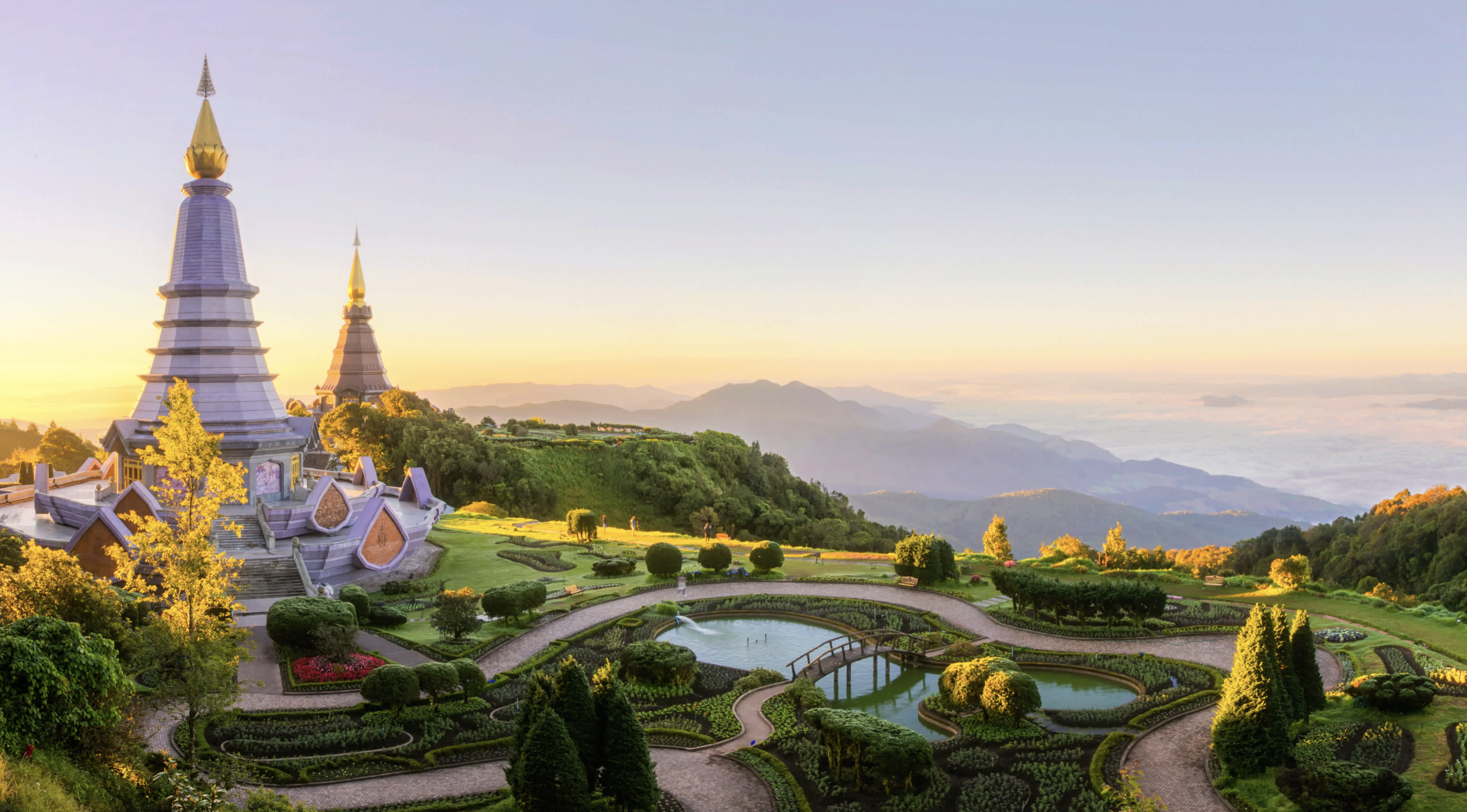Since my last trip to Chiang Mai, I’ve found myself daydreaming about it more often than any other place I’ve visited, and trust me, that says a lot. Chiang Mai is easily in my top five destinations in the world, and I don’t say that lightly.
There’s something about the city’s balance, the way golden temple spires rise above quiet old streets, how the aroma of street food blends with incense from nearby shrines, and how just an hour away, the chaos of the world fades into misty mountains and rice terraces.
This 3-day Chiang Mai itinerary is crafted from both experience and local insight, a mix of what I did, what I wish I’d done sooner, and what locals insist you must not miss.
Day one takes you deep into the Old City, where ancient temples like Wat Phra Singh and Wat Chedi Luang tell stories older than most nations.
Day two is all about elevation, literally as you wind your way up to Doi Suthep for views that make waking up early absolutely worth it.
And on day three, it’s time to slow down and reconnect, with nature, with kindness, and with the elephants at a truly ethical sanctuary.
Whether it’s your first trip or your fifth, Chiang Mai has this quiet magic that never really leaves you.
So here’s how to make the most of three unforgettable days in this soulful northern gem, the way the locals (and I) think it’s best experienced.
Day 1: Temples, Coffee & The Old City
Your first day in Chiang Mai should begin inside the walls of the Old City (Old Town), where the heart of northern Thailand’s history still beats. The Old City is compact, walkable, and filled with temples, cafes, and art galleries.
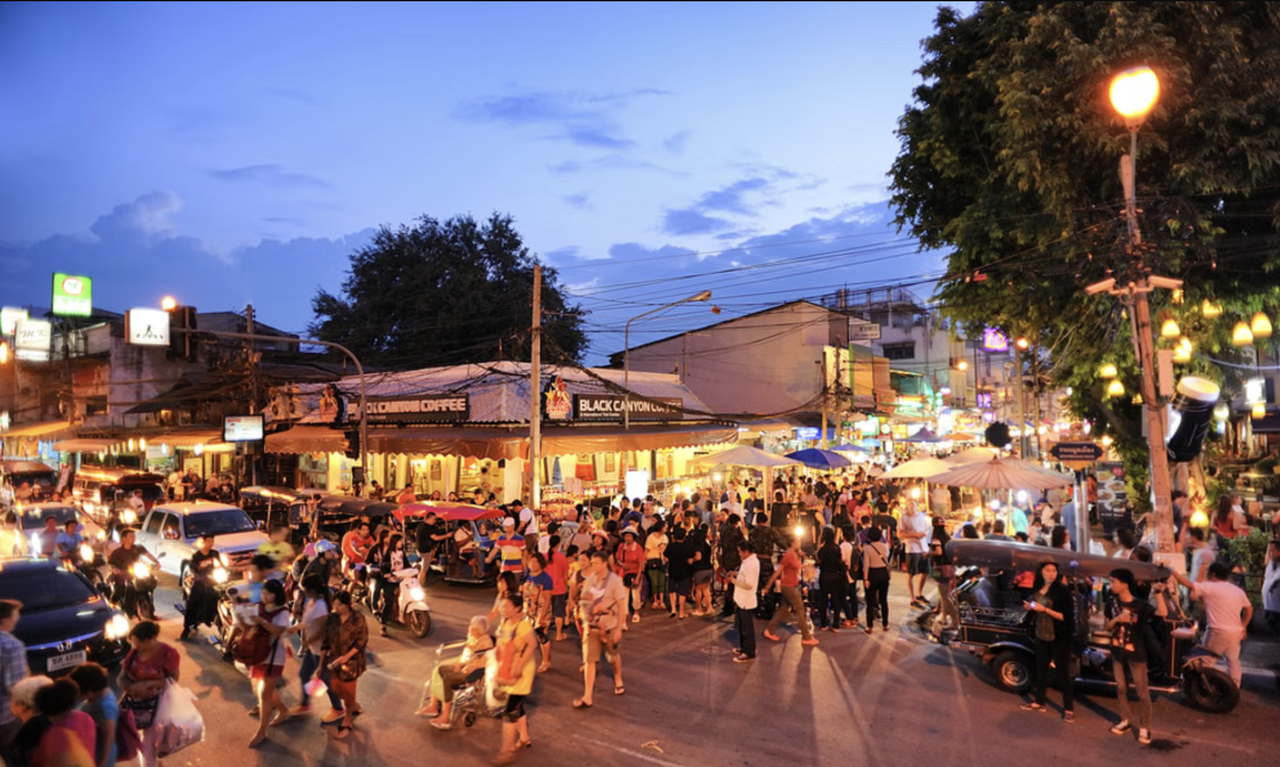
Morning: Start early to catch the soft golden light on the ancient temples. Begin at Wat Phra Singh, one of Chiang Mai’s most revered temples. The elegant architecture, serene atmosphere, and gentle hum of morning chants make it a spiritual introduction to the city. From there, wander over to Wat Chedi Luang, where the crumbling Lanna-style chedi still stands tall after centuries. You might even get a chance to chat with local monks during the “monk chat” sessions.
After a slow temple morning, stop for brunch at Graph Café, known for serving some of the best coffee in Thailand. Chiang Mai’s coffee scene is legendary, thanks to the nearby mountains that grow world-class beans.
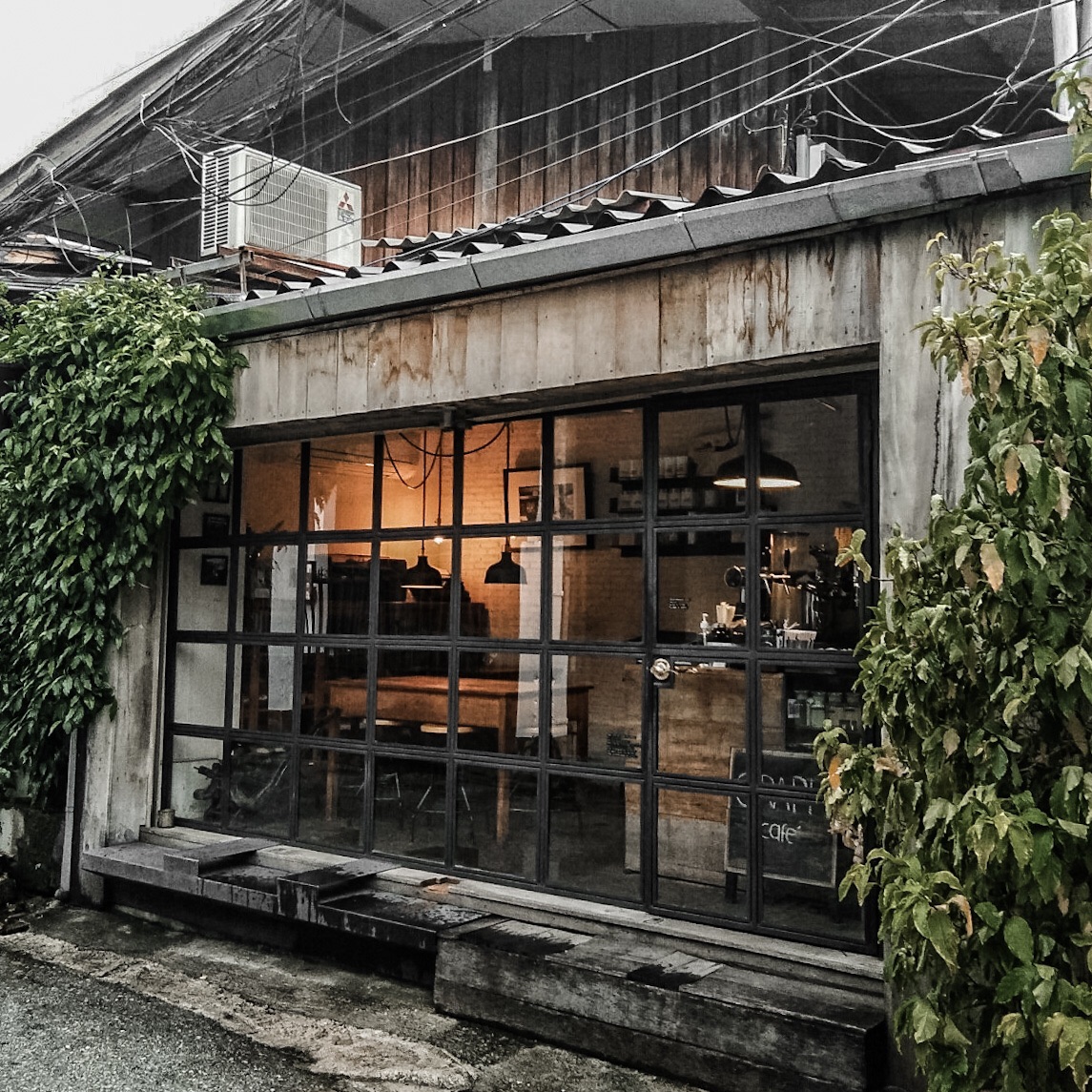
Afternoon: Spend the afternoon exploring the Old City’s lanes. You’ll find tiny shops selling handmade crafts, coconut ice cream stands, and massage parlors offering affordable traditional Thai massages. For lunch, try Khao Soi Khun Yai, a humble street-side spot famous for serving Chiang Mai’s signature dish, Khao Soi (a coconut curry noodle soup that’s pure comfort in a bowl).
If you’re into art and culture, head to the Chiang Mai City Arts & Cultural Centre or the Lanna Folklife Museum for a short visit. Both give a wonderful overview of the region’s deep-rooted traditions.
Evening: When the sun begins to set, walk to the Tha Phae Gate, the iconic eastern entrance of the Old City. The square comes alive in the evenings with street performers, food stalls, and musicians.
For dinner, go to Dash Restaurant and Bar, which offers authentic Thai dishes in a charming teak house setting.
If it’s a Sunday, don’t miss the Sunday Walking Street Market, one of the best night markets in Thailand. You can shop for local crafts, try mango sticky rice, or get a foot massage right on the street.
Day 2: Mountains, Views & Temples in the Sky
Today’s all about going up, literally. It’s time to explore the mountains surrounding Chiang Mai.
Morning: Get an early start and drive (or take a songthaew) up to Doi Suthep, the mountain that defines Chiang Mai’s skyline. The ride itself is scenic, winding through lush jungle roads until you reach Wat Phra That Doi Suthep, perched dramatically on the mountainside.
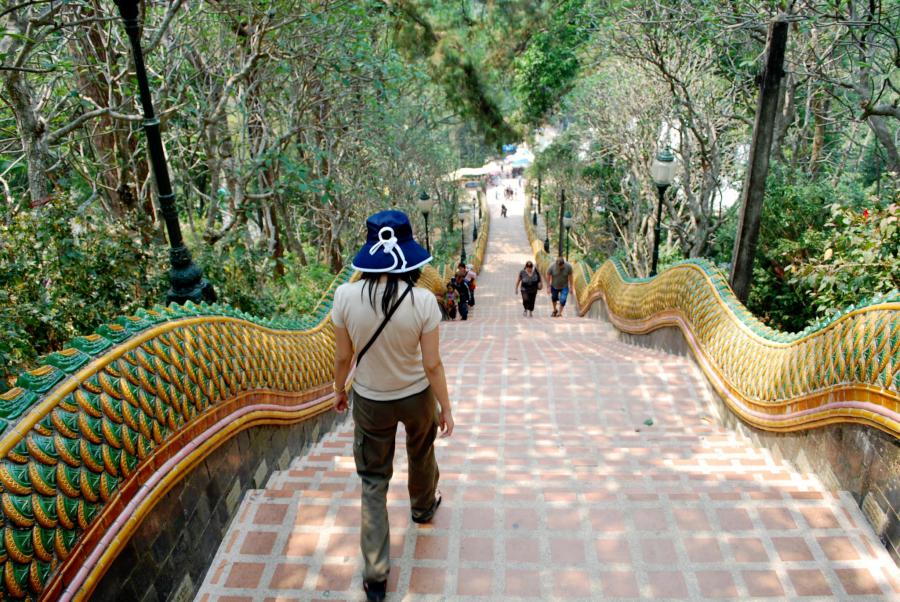
Climb the 300 steps guarded by Naga serpents or take the funicular if you prefer. The temple’s golden stupa gleams in the sun, and the panoramic views of Chiang Mai below are unforgettable, especially in the morning light.
After your temple visit, stop at Mon Cham, a hilltop area about an hour away known for its flower fields, scenic views, and cool mountain air. You can grab coffee at Giant Chiang Mai Café, a treehouse café that lives up to its name, or enjoy lunch at one of the hilltop restaurants with stunning valley views.
Afternoon: On your way back, visit Bhubing Palace, the royal winter residence surrounded by landscaped gardens, or Hmong Village, where you can explore local crafts and traditional clothing. These stops offer a glimpse into the region’s cultural diversity.
Evening: Return to the city for dinner at Tong Tem Toh, one of Chiang Mai’s most loved northern Thai restaurants. Try the Nam Prik Ong (a spicy tomato-based dip) or Sai Ua (Chiang Mai sausage). If you’re up for more exploring, check out the Nimman area, Chiang Mai’s trendy neighborhood filled with rooftop bars, boutique shops, and creative spaces.
Day 3: Elephants, Nature & Relaxation
Your final day in Chiang Mai should be about connection, with nature, animals, and the slower pace of northern Thailand.
Morning: Book a visit to an ethical elephant sanctuary such as Elephant Nature Park or Happy Elephant Home. These sanctuaries focus on rescue and rehabilitation rather than tourist rides, allowing you to feed, bathe, and walk alongside these gentle giants in a natural environment. Spending a few hours here is deeply moving and a great way to support ethical tourism.
Afternoon: After your sanctuary visit, head back toward the city and stop at one of the waterfalls near Chiang Mai, like Bua Thong (Sticky Waterfall). You can actually climb up the limestone rocks without slipping, a fun and unique experience surrounded by lush forest.
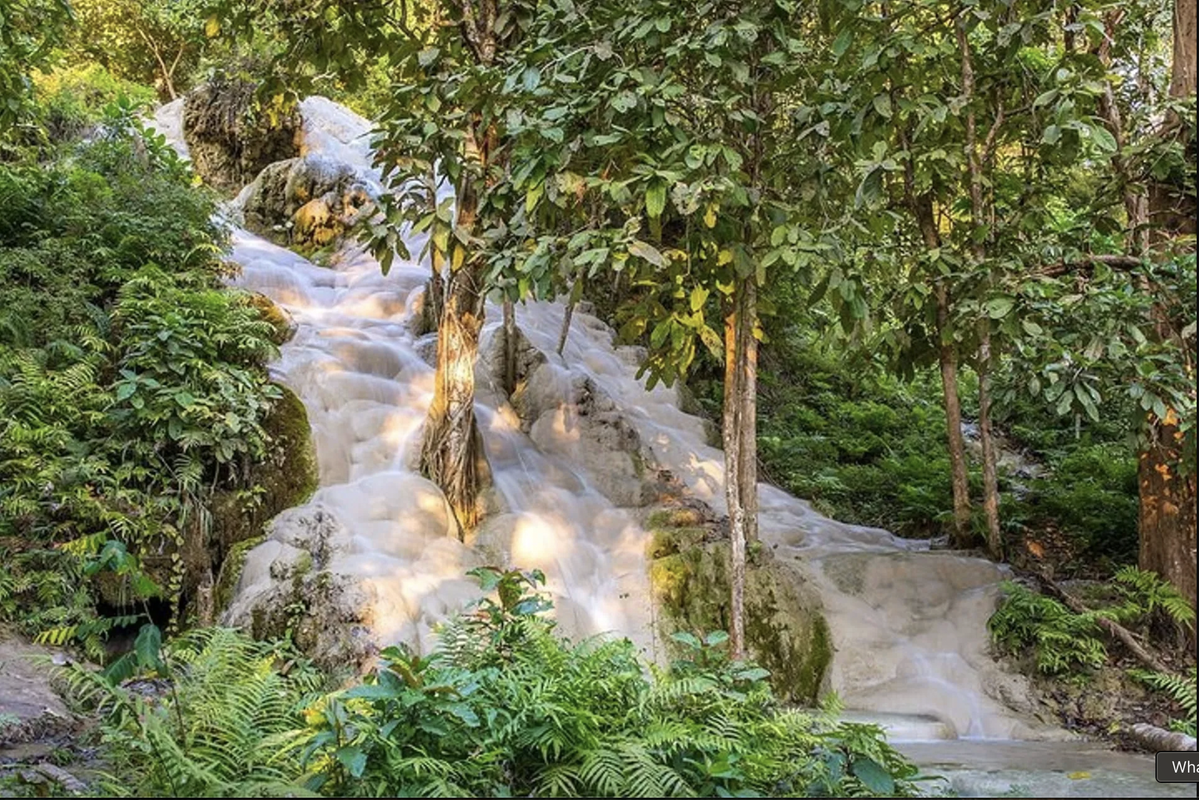
Evening: For your final night, treat yourself to a spa session. Fah Lanna Spa or Oasis Spa offer excellent Thai massages in peaceful settings.
Then, have dinner at The Riverside Bar & Restaurant, where you can enjoy live music and good food right by the Ping River. Watching the lanterns drift in the evening breeze is the perfect way to wrap up your trip.
Practical Tips for Visiting Chiang Mai
1. Getting Around: Chiang Mai is easy to navigate. Within the Old City, walking or renting a bicycle works well. For longer trips, use songthaews (red trucks), Grab, or rent a scooter if you’re comfortable riding.
2. When to Visit: The best time to visit is from November to February, when the weather is cool and pleasant. If you visit in April, you can experience Songkran, Thailand’s famous water festival.
3. Dress Respectfully: When visiting temples, wear modest clothing — shoulders and knees covered. Always remove your shoes before entering temple grounds.
4. Stay Hydrated: Chiang Mai can get quite warm during the day. Carry a reusable water bottle, filtered refill stations are common.
5. Book Activities in Advance: Ethical sanctuaries and popular cooking classes fill up fast, so book a few days ahead.
Scams to Avoid in Chiang Mai
1. Elephant Riding Camps: Avoid any tours offering elephant rides or performances. These are not ethical and often involve animal mistreatment.
2. Overpriced Tuk-Tuks: Always agree on a price before getting in. In some cases, Grab may be cheaper and more reliable.
3. Gem or Handicraft Scams: Beware of drivers suggesting “special shops” with “exclusive deals.” These are often overpriced tourist traps.
4. Motorbike Rentals: Take photos of the bike before you rent it to avoid damage disputes later. Choose a reputable rental shop and check reviews first.
5. Fake Monk Donations: Some people dressed as monks may approach tourists for money — real monks don’t beg or pressure you for donations.
FAQs About Chiang Mai
Q: Is 3 days enough for Chiang Mai?
A: Three days is perfect to experience Chiang Mai’s highlights — temples, Doi Suthep, and a sanctuary. But if you have extra time, stay 5–7 days to explore nearby national parks and villages.
Q: How do I get to Chiang Mai?
A: Chiang Mai has an international airport (CNX) with direct flights from Bangkok, Phuket, and several Asian cities. You can also take an overnight train from Bangkok, a classic Thai travel experience.
Q: What should I eat in Chiang Mai?
A: Don’t miss Khao Soi, Sai Ua (Chiang Mai sausage), Nam Prik Ong, and mango sticky rice. The city’s night markets are perfect for trying it all.
Q: Is Chiang Mai safe for solo travelers?
A: Absolutely. Chiang Mai is one of the safest and most welcoming cities in Southeast Asia. Just use basic precautions as you would anywhere.
Q: Can I visit an elephant sanctuary in one day?
A: Yes. Most ethical sanctuaries offer half-day or full-day programs including transport, meals, and activities.
My Personal Tips and Experiences in Chiang Mai
Over multiple trips, I’ve picked up a few lessons and discoveries that turned good days into unforgettable ones. These aren’t the kind of things you’ll always find in guidebooks — they’re the little details that make Chiang Mai truly special.
1. Early mornings are magical.
If you wake up just after dawn and walk through the Old City, you’ll see monks collecting alms, hear temple bells echo softly, and feel the city before the tourists arrive. It’s a moment of peace that feels timeless.
2. Try a local cooking class.
I joined a small class near Warorot Market where we picked fresh herbs and made Khao Soi from scratch. It gave me a whole new appreciation for Thai food — and it’s one of the best souvenirs you can bring home: the ability to cook like a local.
3. Skip taxis — use songthaews.
The red shared trucks are cheap, fun, and give you a slice of local life. You’ll likely end up chatting with locals or fellow travelers along the way.
4. Visit temples in the late afternoon.
Most people visit in the morning, but going around 4–5 PM means softer light for photos and fewer crowds. Watching the sunset from Wat Phra That Doi Suthep as the city lights flicker on below is unforgettable.
5. Explore Nimman on foot.
This neighborhood is filled with chic cafes, indie boutiques, and creative studios. My favorite spot? Ristr8to, a specialty coffee bar that’s pure heaven for caffeine lovers.
6. Massage every day if you can.
Massages are incredibly affordable here — often just a few dollars for an hour. It’s the perfect way to unwind after long walks and temple visits.
7. Respect the elephants.
Even at ethical sanctuaries, don’t expect to touch or pose constantly. Let them approach you on their own terms. It’s far more meaningful that way.
8. Chiang Mai by night is underrated.
After 9 PM, the city quiets down beautifully. Grab a drink by the river, walk through the old walls, or sit by Tha Phae Gate and people-watch — you’ll feel like time has slowed to a heartbeat.
9. Local cafés are everywhere — explore them.
Some of my favorite afternoons were spent sipping cold brew in tucked-away spots I found by accident. Don’t stick to one place — Chiang Mai’s café culture is world-class.
10. If you’re here during Loy Krathong or Yi Peng, plan ahead.
These lantern festivals are breathtaking, but they also bring massive crowds. Book hotels early, and head to a local temple instead of the main tourist areas for a more authentic experience.
Written By Ayesha Harris.
